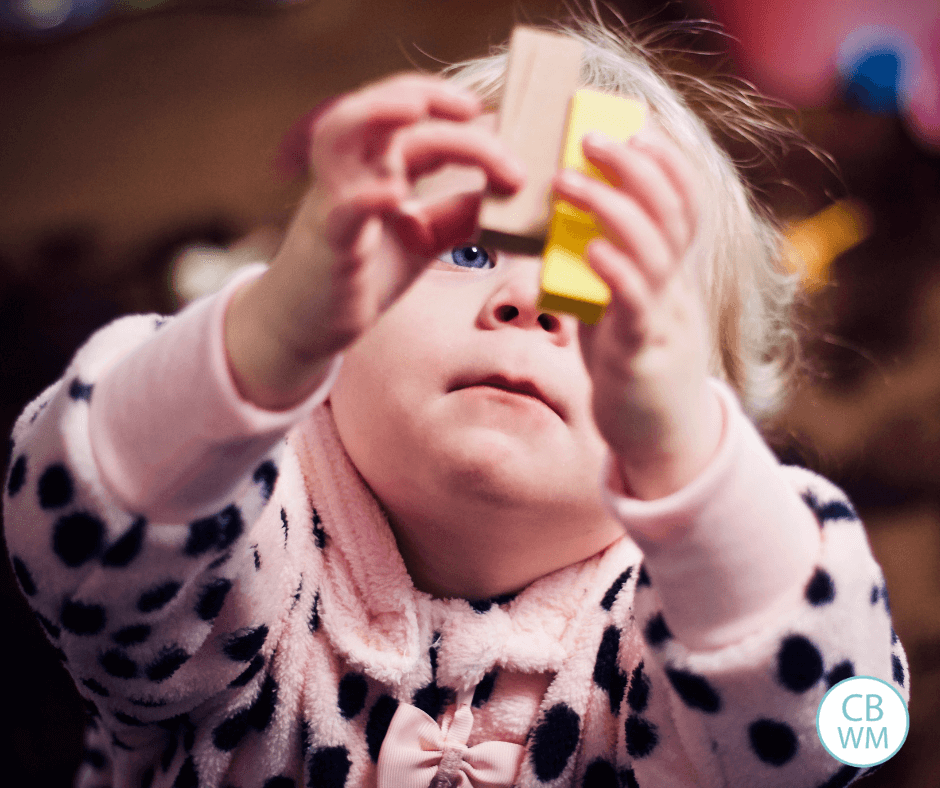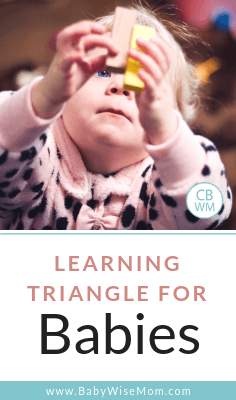Learning Triangle for Babies. Know what your baby is capable of focusing on and learning developmentally so you don’t overwhelm baby.
Tracy Hogg has a rule for what you give to your child to play with. That rule is that parent’s stay within their child’s learning triangle (146). That means you only give your child mental and physical tasks that your baby can accomplish alone. When your baby has a toy, observe rather than jump in.
As parents we are often eager to see our child accomplishing the milestones and to start playing with the fun toys we have available. The child might enjoy certain toys before the toy is age appropriate, but usually only so long as mom or dad is there to help him manipulate it. As soon as the child is left to his own devices, he becomes frustrated because he just can’t do it.
To judge what can fit in your child’s learning triangle, consider his accomplishments to date. What can he do. Tracy Hogg says don’t look in a book, look at your baby. Can he sit up? Can he grab things? Here are some guidelines.
Post Contents
Learning Development Milestones for Baby
Baby Mostly Watches and Listens
- 6-8 weeks
- At this age, baby is mostly one who looks and listens. He becomes more aware of hers surroundings as time goes on.
- Babies this age like to look at lines.
- You can draw lines on white piece of paper using a black marker for him to look at.
- Primary colors stimulate baby.
- Pastel colors calm baby.
- Machines that mimic sounds of womb might be a good toy for this age.
- You can sing or play songs of lullabies.
Baby Gains Control Over Head and Neck
- Usually around 2-3 months
- A mobile for crib and playpen might be a good toy for this age. Don’t position right above because baby turns head to the side.
- Pictures of phases are a favorite among this age group.
- Mirrors are also a good toy for this age.
- Keep in mind that baby cannot yet move herself when something is too stimulating for her. If she starts to fuss and is done, you need to move her or change her scenery.
- Hands often become a toy, but usually by accident.
- You can sing or play songs of lullabies.
Baby Reaches and Grasps
- 3-4 months
- Anything is fascinating for this baby to grab–including his own body parts.
- Most everything goes straight to his mouth.
- He loves to play with Mommy or Daddy (or perhaps a sibling).
- Rattles and other safe, simple toys are good.
- Choose toys that are responsive, generate noise, and/or feel good to the touch.
- He loves to explore.
- He loves to see his actions cause a reaction.
- Comprehends cause and effect.
- He coos and knows how to get your attention (he might drop the toy, cough, or cry).
- You can sing or play nursery rhymes. Don’t do too much (try one song per waketime).
Baby Rolls
- 3-5 months
- Still loves toys that make noise.
- Also loves normal household items like spoons.
- She is a scientist and loves to explore.
- Is interested in playing with shapes, like cubes, balls, or triangles.
- You can sing or play nursery rhymes. Don’t do too much (try one song per waketime).
Baby Sits Up
- 6 months old
- Can transfer objects from hand to hand.
- He can point and gesture.
- As he is playing and exploring, give him the opportunity to problem solve on his own. You can cheer him on, but let him control himself (within reason).
- Give simple toys that reinforce actions. Simple jack-in-the-box, for example.
- You can sing or play nursery rhymes. Try three songs per waketime.
Baby Moves
- 8-10 months old
- Create a safe environment.
- Cognitive skills are improving.
- She will love to move to work off her energy.
- She will find ways to make noise.
- She loves toys that encourage her to put things in and take things out. At first they empty. Eventually she will start to put back (10-12 months).
- Rolling toys are good, especially ones to pull toward her.
- Peek-a-boo is a favorite at this age.
- Use household items as playthings.
- You can sing or play nursery rhymes. Try three songs per waketime. You can also add movements easy enough for baby to imitate.
12 months old
- In your song time, sing or play nursery rhymes. Try four songs per waketime and play each song twice. You can also add gestures.
See this post for more on toys: Out With the Old, in With the New (toys)
 Secrets of the Baby Whisper...Shop on Amazon
Secrets of the Baby Whisper...Shop on Amazon


